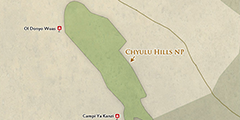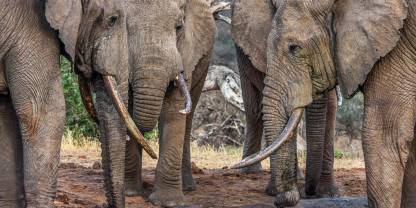Little-visited Chyulu Hills National Park was made famous as Ernest Hemingway’s ‘Green Hills of Africa’. They’re among the youngest mountain ranges on earth, having been formed by volcanic upheaval only about 500 years ago. The park’s Upper Leviathan Cave is one of the world’s longest caves. Sadly, human encroachment and poaching are major problems here and there isn’t much wildlife around.

-
Best Time To Go
- June to October and January to February
-
High Season
- December to March and July to October (Not busy)
-
Size
- 741km² / 286mi²
-
Altitude
-
992-2,041m /3,255-6,696ft
 View Photos
View Photos
 View Photos
+1
Photos
View Photos
+1
Photos
 Open Map
Open Map
Pros & Cons
- Untouristy, off-the-beaten-track destination
- Caving and trekking trips can be organized
- Beautiful volcanic scenery
- Excellent bird watching
- There is very little wildlife
- No lodges within the park, only a campsite
- Roads are in poor condition
Wildlife
Wildlife densities are low and animals are nervous. You’re unlikely to see much more than the occasional klipspringer, giraffe, zebra, baboon and . To see what Chyulu Hills was once like, head for the western slopes (outside the park and accessible from the Amboseli region) where the Maasai, working with two upmarket lodges, help protect rhino, elephant and lion.
Scenery
From a distance, the Chyulu Hills look green and inviting, their jagged ridges rising from dusty plains. Up close, these mountains are a dark world of black volcanic soil, black rocks, ash cones and barren lava flows. The upper slopes are home to 37 species of orchids. Deep beneath the hills is a catacomb of mostly unexplored caves.
Activities
Unlike most other Kenyan parks and reserves where wildlife viewing is the main activity, in Chyulu Hills you can look forward to caving. The Upper Leviathan Cave is 11.5km/7mi long and worth exploring, but caves (many of them unexplored) fill the hillsides here. Make sure your operator has the requisite experience and equipment before venturing into this remarkable underground world.
Weather & Climate
The weather and climate of Chyulu Hills is comparable to that of Tsavo West National Park. More info:
Best Time To Visit
Chyulu Hills can be visited year-round, but the best time is during the dry months, from June to October and January to February. During the short rains (November) and the long rains (April and May), road conditions can be challenging. A sturdy 4x4 vehicle is required throughout the year. With heavy rainfall comes the risk of caves flooding.
How To Get to Chyulu Hills NP
Chyulu Hills is usually visited as a side trip from Tsavo West, or en route between Amboseli National Park or Nairobi and the coast. It is 232km/144mi from Nairobi and 250km/155mi from Mombasa. Safarilink flies to ol Donyo Lodge (which is just outside Chyulu Hills National Park) from Nairobi-Wilson and Amboseli.
Health & Safety
Please read our malaria and vaccinations page for Kenya and our general ‘Wildlife Viewing Safety Precautions’ for more info:

